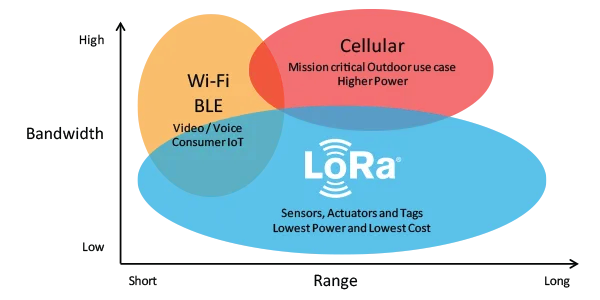Over the last few years, LoRa® technology has established itself as an essential component in the Internet of Things (IoT) landscape. While it is widely acclaimed in the industrial and urban world for its range and energy efficiency, it also represents a formidable field of exploration for radio amateurs keen to combine experimental practice and digital innovation.
LoRa® is not just another alternative among the many wireless communication technologies available. It is a bridge between robust low-tech and the most modern connected infrastructures. For those who, like me, are interested in radio communications for technology watch or personal passion, LoRa® offers a unique opportunity to reconnect with radio experimentation in all its richness.
Definition and operating principles
Designed for infrequent transmissions over long distances, LoRa® – which stands for Long Range, Low Power – is based on low-speed radio communication optimised for energy-constrained environments. Its low power consumption allows it to power autonomous devices for several years, a decisive advantage in scenarios such as battery-powered sensors or isolated stations.
The core of this technology lies in its Chirp Spread Spectrum (CSS) modulation, a method that encodes information via linear frequency sweeps. This modulation gives signals exceptional robustness against interference and multi-path propagation, while ensuring significant spectral efficiency. By adjusting the spread factor, it is possible to balance throughput and range according to the needs of the application.
The transmission speed offered by LoRa® is deliberately limited, generally ranging from a few dozen bits per second to a maximum of around 50 kbps depending on the configuration. This low speed is a result of the fundamental trade-off inherent in the technology: sacrificing speed in favour of range and robustness. The higher the spreading factor (up to SF12), the greater the range… but the lower the data rate. Conversely, a lower factor (such as SF7) allows for faster data rates, but over shorter distances.
Although LoRa® only defines radio modulation1, it is frequently used in a more comprehensive architecture called LoRaWAN®, which allows communications to be organised on a structured and secure network2.
LoRaWAN®: a network layer designed for the IoT
LoRaWAN® (Long Range Wide Area Network) is a network communication protocol that uses the LoRa® physical layer to build long-range, low-power transmission infrastructures. It connects a set of sensors (or nodes) to a central server via radio gateways, while ensuring message encapsulation, security and management. This hierarchical architecture makes LoRa particularly well suited to distributed use cases such as environmental monitoring, infrastructure management and connected agriculture.
In this configuration, LoRaWAN® excels at transmitting small amounts of useful data over long distances. Thanks to its low bandwidth, it provides extensive coverage with minimal energy consumption. This positioning clearly distinguishes it from solutions such as Wi-Fi or Bluetooth, which prioritise high speeds at the expense of range.

In addition to its robust modulation, LoRa(WAN) is uniquely positioned in the wireless technology landscape. It enables the transmission of small payloads over long distances while using low bandwidth. This compromise between range and throughput makes it an ideal solution for sensor applications spread over large areas. The following illustration shows how it compares to other competing technologies.
illustration : The Things Network
Frequency of use and regulatory framework
One of LoRa®’s major advantages is its compatibility with free frequency bands, which makes it much easier to experiment with.
- In Europe, the 868 MHz band is mainly used, particularly in urban areas due to its penetration capacity. (In the USA, the 915 MHz band is used
- The 433 MHz band remains of interest to experimenters in Belgium. However, this is only the case within the so-called ‘EU433’ band (433.05 to 434.79 MHz) in accordance with CEPT ERC/REC 70-03, adopted by Belgium.
- The 2.4 GHz band (2.4–2.4835 GHz), which is more susceptible to interference, has certain specific applications. However, this band is used for WLAN and other wireless technologies.
It is essential to comply with the regulations in force in each country, particularly with regard to transmission power and duty cycle.
LoRa®’s actual throughput: a compromise between range and capacity
Contrary to popular belief, LoRa® technology — particularly on sub-GHz bands such as 433 MHz or 868 MHz — is not designed for high throughput, but rather for reliability and range. In a standard configuration (125 kHz bandwidth, SF7 spreading factor), the maximum theoretical data rate is around 5.5 kbps. If you prioritise increased range with a higher spreading factor (such as SF12), this data rate can drop to a few hundred bits per second.
Here is a comparative summary of LoRa®’s capabilities according to the band used:
| Frequency band | Maximum theoretical flow rate | Typical use |
|---|---|---|
| 433 / 868 / 915 MHz | Up to 5.5 kbps | Long-range, low-power IoT transmission |
| 2,4 GHz | Up to 253 kbps | Short-range applications, high throughput possible |
In summary: the greater the range, the lower the data rate — this is the technical compromise made by LoRa®, which fundamentally distinguishes it from technologies designed for streaming or transmitting large amounts of data.
A fertile ground for radio amateurs
The growing enthusiasm of amateur radio operators for LoRa® is no coincidence. The experimental approach it allows, without licence restrictions (within the limits of ISM bands), opens the door to exciting and varied technical projects.
Notable examples include adaptations of the APRS3,4 system in its LoRa-APRS version, which uses 433 MHz modules for low-power telemetry. Some enthusiasts have also turned to receiving telemetry data from nanosatellites operating in LoRa®5. Others are actively participating in community networks such as The Things Network, pooling LoRaWAN® gateways to provide open and decentralised coverage.
Implementation and resources
The LoRa® community now benefits from a rich and mature ecosystem. Numerous modules are available on the market, such as the RFM95W, Heltec cards with OLED screens and Wi-Fi, and Python-compatible LoPy modules. Software integration is also facilitated by open source libraries such as RadioHead, LMIC and the very popular LoRa® library for Arduino.
Complete kits and development platforms are offered by specialised distributors, including Elektor and Swiss-ARTG, enabling engineers, technicians and knowledgeable amateurs to quickly move from idea to working prototype.
Technology ecosystem and governance
The rise of LoRa® is largely due to the efforts of the LoRa Alliance, an industry consortium responsible for ensuring the interoperability, certification and evolution of the LoRaWAN protocol. By setting open standards and promoting a collaborative framework, the organisation guarantees the stability of the technology base while fostering global innovation.
From short waves to smart grids: the circle is complete
LoRa is not just an Internet of Things technology: it is also a valuable tool for engineers and amateur radio explorers. Its ability to combine range, energy efficiency and ease of implementation makes it a vehicle for sustainable and innovative projects. Whether in a professional setting or as an enthusiast, embracing LoRa means participating in a rewarding convergence between emerging technologies and experimental radio practice.
- physical layer of the OSI model ↩︎
- data link layer of the OSI model ↩︎
- https://github.com/lora-aprs/LoRa_APRS_Tracker ↩︎
- UBA, CQ-QSO 202205, Technical Article – APRS using LoRa technology ↩︎
- https://tinygs.com/ ↩︎
